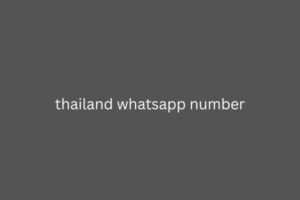As with advertorials, you need to consider any links a website may point to you that could be considered promotional links.
Paid links don’t always mean exchanging money for links.
Promotional links that are technically paid links in Google's eyes include any thailand whatsapp number links provided in exchange for a free product review or product discount.
While these types of links were fine a few years ago, now they need to be nofollowed.
You’ll still get the value of the link, but it won’t be through helping with rankings, but rather through brand awareness and traffic.
You may have links from a promotion several years ago that are now having a negative impact on your site.
For all of these reasons, it’s crucial to evaluate each link individually. You need to remove poor quality links because they will affect Penguin or could lead to future manual actions.

However, you don’t want to remove good links because these links help you rank in search results.
Promotional links that are not nofollowed will also trigger manual actions on outgoing links on the sites where they are placed.
Penguin populations have yet to recover?
Sometimes, webmasters do everything they can to clean up their link profiles and still don’t see an increase in traffic or rankings.
There may be many reasons for this, including:
Before the algorithmic penalty, the initial traffic and ranking boost was unjustified (and likely short-lived) and came from bad backlinks.
When links are removed, no effort is made to acquire new, more valuable backlinks.
Not all negative backlinks have been disavowed/enough negative backlinks have been removed.
First of all, this question is not link based.
When you recover from Penguin, don’t expect your rankings to return to pre-Penguin levels, and don’t expect the recovery to be immediate.
Many website owners thought that once Penguin was lifted, their sites would immediately rank high for popular search queries.
First, some of the links you disavow may result in artificially high rankings, so you can’t expect those rankings to be as high as they were before.
Second, because many website owners have difficulty evaluating the quality of links, some high-quality links that once contributed to higher rankings are inevitably negated in the process.
Plus, Google is constantly changing its ranking algorithms, so what worked in your favor before might not have as much of an impact now, and vice versa.
One of the great things about the SEO industry and its practitioners is that it is a very active and vibrant community, with new theories and experimental results being published online every day.
Naturally, this has led to many misconceptions and misunderstandings about Google’s algorithm. Penguin is no exception.
Here are some of the myths and misunderstandings we’ve seen over the years regarding the Penguin algorithm.
Myth: Penguins are a punishment
One of the biggest misconceptions about the Penguin algorithm is what people call a penalty (or what Google refers to as a manual action).
The Penguin attack was strictly algorithmic in nature. Google was unable to manually undo the attack.
While both algorithm changes and penalties can cause a significant drop in a site's rankings, there is a considerable difference between them.
A penalty (or manual action) occurs when a member of the Google webspam team responds to a flag, investigates, and deems it necessary to impose a penalty on a domain.
You will receive a notification related to this manual action through Google Search Console.
When you are affected by a manual action, you are not only required to check your backlinks and submit disavowals for spammy links that violate Google guidelines, but you are also required to submit a reconsideration request to the Google webspam team.
If successful, the penalty is removed; if unsuccessful, the backlink profile is reviewed.
Penguin downgrades don't require any input from Google team members. Everything is done algorithmically.
Previously, you had to wait for a refresh or algorithm update, but now Penguin works in real time, so recovery is much faster (if enough remediation work has been done).
Myth: Google will notify you if Penguin visits your site
Another misconception about the Google Penguin algorithm is that you will be notified when the algorithm is applied.
Unfortunately, this is not the case. Search Console will not notify you that your rankings have dropped as a result of applying Penguin.
Again, this shows the difference between an algorithm and a penalty – if you are penalized, you will be notified.
However, the process of recovering from the Penguins is very similar to the process of recovering from a penalty.
Myth: Denying bad links is the only way to reverse Penguin
While this strategy can remove a large number of low-quality links, it is time-consuming and can be a waste of resources.
Google Penguin compares the percentage of good links to spammy links.
So, instead of focusing on manually removing those low-quality links, you should focus on increasing the number of high-quality links to your website.
This will have a better impact on the percentages considered by the Penguins.
Myth: You can’t recover from a penguin plague
Yes, you can recover from Penguin.
It is possible, but it takes some experience to deal with the fickle nature of Google’s algorithm.
The best way to get rid of the negative impact of Penguin is to forget all the existing links on your site and start getting original links provided by editors.
The more quality links you get, the easier it will be to keep your site out of Penguin’s clutches.